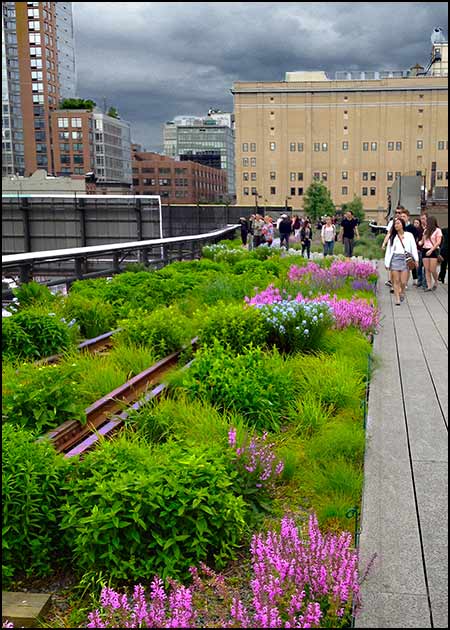 The Heavenly High Line
The Heavenly High Line
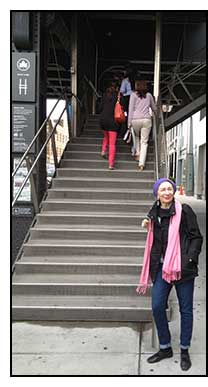 I climbed a real stairway to heaven last spring. Its broad metal steps led to a tidy railroad platform perched 30 feet above the cobblestone streets of this part of New York City.
I climbed a real stairway to heaven last spring. Its broad metal steps led to a tidy railroad platform perched 30 feet above the cobblestone streets of this part of New York City.
I had arrived at the High Line, a one-and-a-half-mile promenade on the west side of Manhattan that is suspended above the meatpacking district, from Gansevoort to 34th Streets.
After I marveled at the wild landscaping that lined the tracks, and absorbed stunning views of the Hudson River and the Manhattan skyline, I joined a stream of thousands who, like me, were going nowhere in particular.
My sister Selma’s 70th birthday reunion had 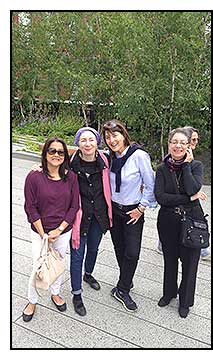 brought me to The Big Apple last spring. Prior to my departure I learned about the High Line from my friend, Dan Cosper, who said, “You’ve got to see this place,” and a visit to the High Line’s informative and graphic website settled the matter once and for all.
brought me to The Big Apple last spring. Prior to my departure I learned about the High Line from my friend, Dan Cosper, who said, “You’ve got to see this place,” and a visit to the High Line’s informative and graphic website settled the matter once and for all.
So I e-mailed my nephew, Robbie, before I left town and said, “I want to visit the High Line come hell or high water,” and Robbie, a Manhattanite, organized a birthday expedition to the High Line for interested family and friends, on a beautiful Saturday morning.
The New York Central ran freight trains along the High Line between 1934 and 1980. Prior to 1934 the 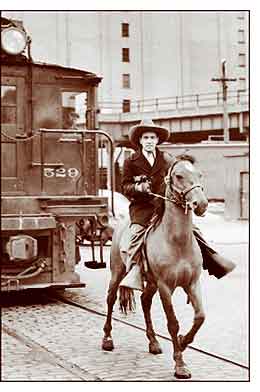 line ran on street level, policed by the “West Side Cowboys” who rode horses and waved red flags in an attempt to keep the trains from causing lethal collisions. In 1929, at the cost of $2 billion of today’s dollars, the tracks were raised above 105 street-level crossings and the 13-mile High Line was born.
line ran on street level, policed by the “West Side Cowboys” who rode horses and waved red flags in an attempt to keep the trains from causing lethal collisions. In 1929, at the cost of $2 billion of today’s dollars, the tracks were raised above 105 street-level crossings and the 13-mile High Line was born.
Once considered the lifeline of the city, freight trains riding on the High Line delivered produce, milk, meat and manufactured goods directly to warehouses and factories. In 1980 a final shipment of frozen turkeys marked the end of the freight trains’ run on the High Line, and this historic, railroad viaduct fell into disrepair.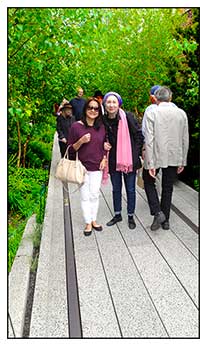
The High Line was eventually donated to the city by CSX Transportation and it is maintained by the Friends of the High Line who provide over 90% of its annual operating budget. Every year millions of people come from all over the world to walk along a promenade made of 12-foot-long tapered planks of concrete. The High Line is now considered a bona fide tourist attraction and a place for locals to meet up, whose popularity has far exceeded its expectations.
Before the High Line became a monument to the industrial history of New York’s West side it was an eyesore to some and an impediment to progress and profit to others. But, to a few individuals with vision, 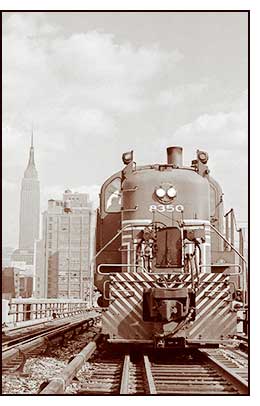 the High Line was a lush, wild, secret garden that had immense potential as a public park.
the High Line was a lush, wild, secret garden that had immense potential as a public park.
Meanwhile, grasses, wildflowers and trees began sprouting between the old wooden ties as the steel rails and iron girders of the 30-foot-high structure began to rust and hunks of concrete began to fall.
So, speculators and city planners made plans to dismantle the High Line — just like they did with the Old Penn Station in 1968. Indeed, the southernmost section of the High Line, almost half the line, had already been demolished and city planners were eager to finish it off for good.
Luckily, in the mid 1980’s, a group of enlightened New Yorkers, still smarting over the loss of the Old Penn Station, challenged demolition efforts in court and kept the High Line from becoming another sad footnote in history.
The Old Penn Station was built on a scale of St. Peter’s in Rome, with Greek Doric columns, 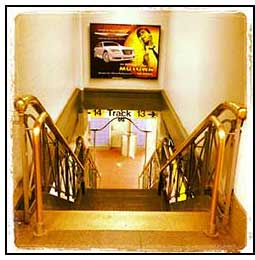 pink granite walls and a waiting room modeled after the Roman Baths of Caracalla. The“new” Penn Station still contains a few remnants of its former glory but most of it is gone. Upon my arrival in Manhattan I saw original, shiny brass railings leading to the cavernous trains.
pink granite walls and a waiting room modeled after the Roman Baths of Caracalla. The“new” Penn Station still contains a few remnants of its former glory but most of it is gone. Upon my arrival in Manhattan I saw original, shiny brass railings leading to the cavernous trains.
Thankfully, what remains of the High Line narrowly escaped the fate of the Old Penn Station. In 1999 The Friends of the High Line raised the money 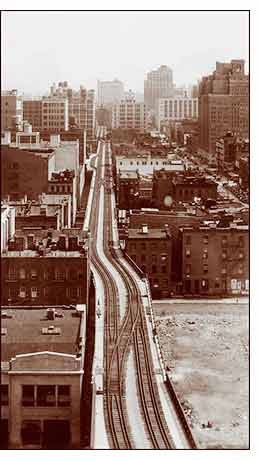 and eventually won the political support they needed to save the place from doom. Ten years later the first of the three sections that make up the High Line was opened to the public.
and eventually won the political support they needed to save the place from doom. Ten years later the first of the three sections that make up the High Line was opened to the public.
The High Line’s planners found inspiration and guidance in a three-mile path called the Promenade Plantée in Paris, built on the right-of-way of the old Vincennes railway line in 1993: Girders were reinforced and repainted, vegetation was tamed, and repairs were made to its sturdy Art-Deco railing. Everything was removed down to the bare steel and concrete of the structure so as to ensure the stability of a structure that was built to carry two fully-loaded freight trains. Eventually, after years of renovation and hard work, it has evolved into one of the world’s 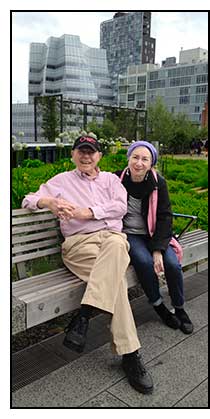 most beautiful linear parks.
most beautiful linear parks.
Besides being a victory for preservationists, the High Line has also become a triumph for capitalism and artistic expression. Not only does it attract rail fans like me but it has also become a serious engine for money-making and a catalyst for creativity.
Dilapidated housing that skirts the High Line has rebounded in value while food trucks jockey for space beneath its majestic structure. Artists, musicians and dancers have also found a place to share their talents while an army of dedicated workers and volunteers lovingly hand-water and tend to the needs of hundreds of trees, shrubs, perennials, grasses, vines, bulbs and wetland plants.
Thanks to the success of the High Line, cities all over the world are now taking a looking at their old buildings, bridges, warehouses and aging 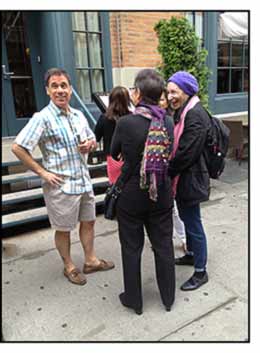 infrastructure with an eye to the future.
infrastructure with an eye to the future.
After our walk on the High Line my nephew Robbie treated us to brunch at the Fig and Olive on West 13th Street where I ordered poached eggs with prosciutto and mushroom, sampled an assortment of multigrain breads, drank freshly-squeezed orange juice and sneaked a few parmesan truffle fries off my nephew’s wife’s plate.
Thank you for visiting chucksville.com. Please sign my guestbook.
Also, thanks to The Friends of The High Line for giving me permission to reproduce the three historic sepia photographs that are found on this page: The photograph of the West Side Cowboy was shot in 1934 by an unknown photographer; James Shaughnessy took the photograph featuring a locomotive known as "View on top of track" in 1953; The last aerial photograph was taken in 1934 by an unknown photographer and is known as "View from West 17th St."
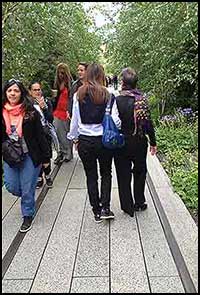
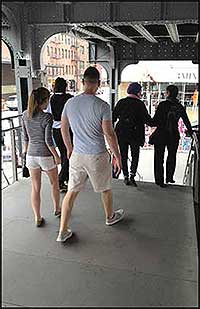
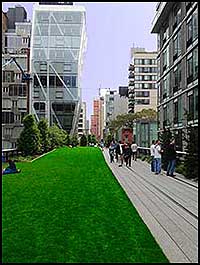
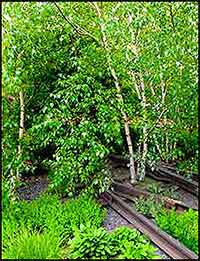
Google search is simple: just type whatever comes to mind in the search box below and hit ENTER or click on the Google Search button. Google will then search the entire chucksville.com website for pages or documents that are relevant to your query!
|
|


